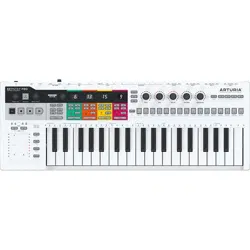Loading ...
Loading ...
Loading ...

3.2. Record and Play a Sequence
The KeyStep Pro features four (!) sequencers - one on each track. Let's record something on
Track 1:
• Press the Track 1 button; it will light up in green
• Select 'Seq' on this track if it isn't already selected
• Now hold the 'Record' button and press the 'Play' button; the step buttons' LEDs
now become active and cycle from Step 1 to Step 16 continuously. We are about
to create our first sequence pattern. Each track can hold 16 of these patterns.
The sequencer is in loop mode, so press a few keys and they will be added to the loop. The
KeyStep Pro sequencers are polyphonic, so pressing a chord instead of a single note will
enter it into the loop. Notice that all notes are recorded with the velocity at which you play
them.
To hear what you've recorded in a step, press the Step Edit button. The sequencer must be
stopped to make this work.
Select a step to preview the notes stored in it. When you press a step, each one of its notes is
played with its properties (Pitch, Velocity, Gate, Randomness and Time Shift). The note with
the lowest time shift value plays instantly, and the others are played based on their timing
offset from this first note. The note with the longest gate in the step determines how long
the step will sound.
Step Edit mode has many more options. We'll further explain these in
Chapter 5 [p.83]
At this point, you can start to 'play around' with your sequence. When you look carefully,
you'll see sequence modifiers printed in blue under the step buttons.
• Hold the 'Shift' key (the leftmost button on the KeyStep Pro) and press 'Semi Up'
or 'Semi Down' to transpose your sequence in half-step increments on the fly.
There are a few other things to try here: 'Shift' + Invert creates a mirror image of your
sequence: the last notes become first, and vice versa. Press 'Shift' + Invert once more to
restore the previous note order.
But it does not stop here: you can shift the entire looping sequence one step to the left or
right. To shift to the right, hold 'Shift' and press Nudge> (step button 4). The first note in the
loop will move to second position; the last note will wrap around to first position.
You can make adjustments to the tempo in quantized 1 BPM increments by turning the
Tempo knob. If you need to make finer adjustments, hold 'Shift' while turning the Tempo
knob : this will increment and decrement the tempo in 0.01 steps.
Arturia - User Manual Keystep Pro - Basic Operations 17
Loading ...
Loading ...
Loading ...
